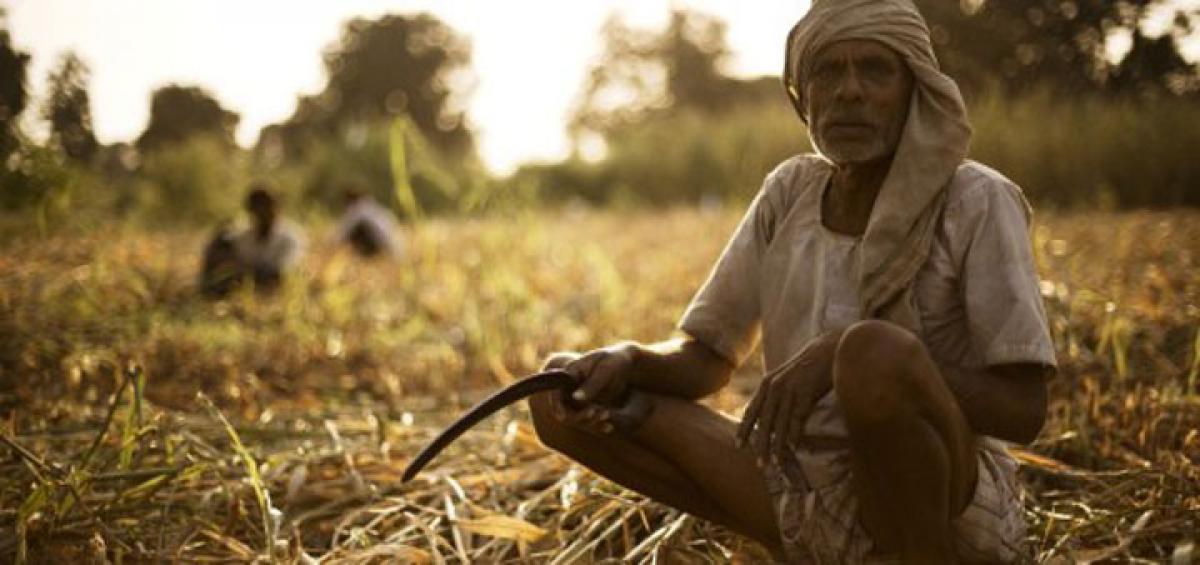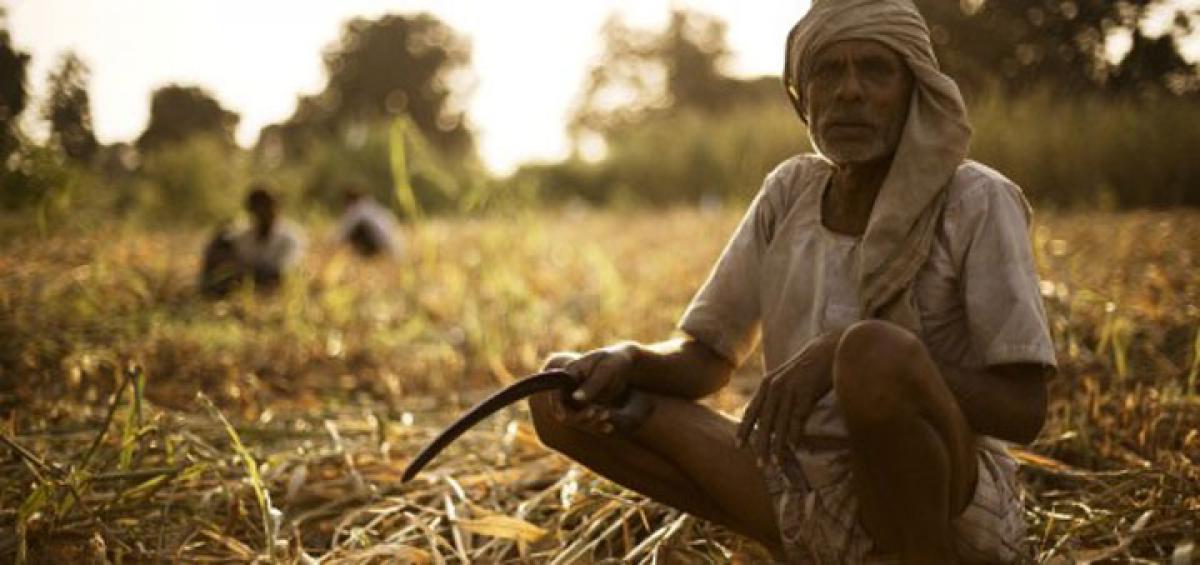Live
- PM Modi highlights govt's efforts to make Odisha prosperous and one of the fastest-growing states
- Hezbollah fires 200 rockets at northern, central Israel, injuring eight
- Allu Arjun's Family Appearance on Unstoppable with NBK Breaks Viewership Records
- Unity of hearts & minds essential for peace & progress, says J&K Lt Governor
- IPL 2025 Auction: I deserve Rs 18 cr price, says Chahal on being acquired by Punjab Kings
- EAM Jaishankar inaugurates new premises of Indian embassy in Rome
- Sailing vessel INSV Tarini embarks on second leg of expedition to New Zealand
- Over 15,000 people affected by rain-related disasters in Sri Lanka
- IPL 2025 Auction: RCB acquire Hazlewood for Rs 12.50 cr; Gujarat Titans bag Prasidh Krishna at Rs 9.5 crore
- Maharashtra result reflects the outcome of Congress' destructive politics: BJP's Shazia Ilmi
Just In

As the tenancy farming is on the rise due to a host of reasons, travails of tenant farmers have now come to the centre of agrarian economic crisis. Over a period of time, the practice of tenant farming is increasingly becoming widespread. The share cropping has given way to tenant farming.
Agrarian distress is more telling on tenant farmers. They have no protection whatsoever as there is no written agreement. They are thus deprived of any government subsidies on credit and inputs. With their fate hinging upon vagaries of nature and charity of land owners, who can drive them out of lands at will, they are forced to approach usurious money lenders.

With tenant fees steeply rising every year and debts mounting, the hapless tenant farmers, in the absence of any protection from the government, are driven into deep distress. Governments have to rise to the occasion and come out with a policy on tenant farming and devise direct benefits to them to lift them out of perennial poverty
As the tenancy farming is on the rise due to a host of reasons, travails of tenant farmers have now come to the centre of agrarian economic crisis. Over a period of time, the practice of tenant farming is increasingly becoming widespread. The share cropping has given way to tenant farming.
The latter is much more distressful. In the share cropping system, the farmer who tills the land invests labour while the produce is shared between the owner and the share cropper. There was even a practice of the land owner contributing full or part of the investment, too. Even if crop is lost, the distress used to be shared by both the land owner and the cultivator. But, of late, tenant farming has replaced share cropping where the cultivator or the tenant farmer has to pay a fixed price as rent even before cultivation.
The land owner does not share the cost of cultivation, but appropriates all government subsidies like input subsidies and avails of credit, insurance and relief due to natural calamities. Thus the disproportionate burden of cultivation and crop failure fall entirely on the tenant farmer making his or her life miserable. Thus, there is an increasing trend of tenant farmers comprising a large chunk of farmers committing suicide.
Meanwhile, tenant farming or share cropping, which was hitherto largely confined to wet lands or irrigated areas, has of late even extended to dry land areas. As the yields and production become volatile, even dry land farmers started moving to non-agricultural occupations, giving their land on lease to tenant farmers.
As the agriculture increasingly becomes non-remunerative, there is a growing trend of land owners abandoning farming to look towards other occupations. There are also instances of farmers moving to towns by giving their land on tenancy for reasons like children’s education and health.
Small and marginal farmers having less than one or two hectares of land take couple of acres on tenancy basis and cultivate the land together. The landless take to tenancy farming as they cannot shift or adapt to new occupations. Land is also a symbol of social esteem in rural areas, besides being a hope for economic gain. Landless who suffer from age-old social discrimination prefer to cultivate in search of upward social mobility.
The agrarian distress is resulting in the declining number of days of agricultural employment available in the countryside. Change in cropping patterns and increasing mechanisation is also contributing to this trend. The landless poor are thus resorting to tenancy farming with a hope of adequate employment in their own villages. Entire family invests their labour and meagre resources on these farms. But, the general agrarian crisis disproportionately impacts them.
Hope for access to credit is also driving landless and small and marginal farmers towards tenant farming. The tenancy farming which was earlier prevailing among certain crops is now expanding to almost all the other crops like food grains, horticultural crops and even commercial crops like cotton, chillies, tobacco, sugarcane etc. The extension of tenancy farming to even commercial crops has deepened the agrarian crisis as their cultivation requires higher levels of investment and the crops suffer from high price volatility and production uncertainties.
In Andhra Pradesh alone, there are as many as 20 lakh tenant farmers. Most of these highly vulnerable sections of farming community are also from socially marginalised communities. They have little or no physical or economic assets to fall back on, which increases their vulnerability to market nuances and vagaries of nature.
Not only the number of tenant farmers is increasing year after year, the tenant fees which they have to pay as rent to the land owner for taking land for cultivation is also inflating over the period. Despite crisis gripping the farm sector, the land owners could hike the tenancy fees as the ranks of tenant farmers continue to swell. For instance in Krishna, Guntur and Godavari districts, the tenancy fees increased from Rs 20,000 in 2012-13 to Rs 26,000 to Rs 30,000 per acre now.
This is in addition to growing burden of cost of inputs like seeds, fertilisers, pesticides etc. The tenancy fee is as high as 28 to 33 bags in areas where two crops are raised. The tenancy rate for paddy cultivation under KC Canal, Tungabhadra and Telugu Ganga etc in Rayalaseema is up to Rs 24,000 per acre on an average. Even in dry land areas, a tenant farmer has to pay Rs 10,000 per acre taken for lease.
Similarly even in dry land areas of North Coastal Andhra, the tenant fees is either Rs 8000-10,000 or 12 to 13 bags. The tenant rent for cotton crops increased by Rs 10,000 to Rs 20,000 during the last two years. The tenant farmer growing chillies in Guntur, Prakasham or Kurnool districts pays to the tune of Rs 30,000 to Rs 40,000 per acre.
The rent for sugarcane crop in Krishna, Visakhapatnam and Vizianagaram districts is between 15 to 20 tonnes, which would mean over Rs 40,000. Even vegetable growers have the tenancy burden of a similar range. Thus, the real tenancy rates are much higher than officially fixed rates. Even as the tenancy fee is increasing so rapidly, the productivity of land fails to pick up. Adding to it, the prices in the market are volatile.
There is no record of rights of tenant farmers and there is no protection to them. All the tenancy agreements are on oral basis, only offering no legal or official protection to this most vulnerable section. If a tenant farmer insists on a written agreement, he or she is most unlikely to get land on tenancy as the land owners fear alienation of their lands to the tiller.
Attempts of government to issue Kisan Cards to tenant farmers failed to substantially alter the situation on the ground. As a result, transfer of government largesse to the tenant farmer essentially depends on the charity of the land owner rather than the legitimate right of the former.
The tenant farmer has to live in a state of constant uncertainty as he is at the mercy of the land owner to get land on lease. As there is no guarantee of getting this land on lease next year, the tenant farmer cannot invest in land. The land owner anyhow is disinclined to spend on land as he is not cultivating.
The existing spread of institutional credit does not cover all the farmers and all the credit requirement of farmers. If this is the general situation of the credit penetration in agricultural sector, one can easily understand the plight of a tenant farmer who has no written record to claim to be cultivator. Thus, tenant farmers mostly depend on private money lenders for their credit requirements and reel under the burden of exorbitant rates of interest.
The story of temple lands is a telling tale of exploitative land relations, inflicting much more economic loss on the tenant farmer. Normally, poor farmers and landless should get the rights to cultivate temple lands so that the poor benefits and the temple gets the revenue. But, across the two states – both Telangana and Andhra Pradesh – thousands of acres of temple lands got alienated.
The rich and the powerful encroach upon these lands and give them to tenant farmers on sub lease. In Andhra Pradesh alone, estimates suggest that there are over six lakh acres technically categorised as temple lands, but most of them are under the subjugation of landlords and rich peasants.
Even the court verdicts and the government orders clearly say that the poor and marginalised farmers cultivating these temple lands should not be evicted from these lands. But, the social and the political elite who act as landed gentry in the villages force these poor farmers cultivating temple lands out of these lands.
As the Jayati Ghosh Committee on farmers’ welfare appointed by the united Andhra Pradesh government observed, the burden of agrarian distress has disproportionately fallen on tenant farmers. An urgent policy change is needed on tenant farmers to address the problem of agrarian distress.

© 2024 Hyderabad Media House Limited/The Hans India. All rights reserved. Powered by hocalwire.com







